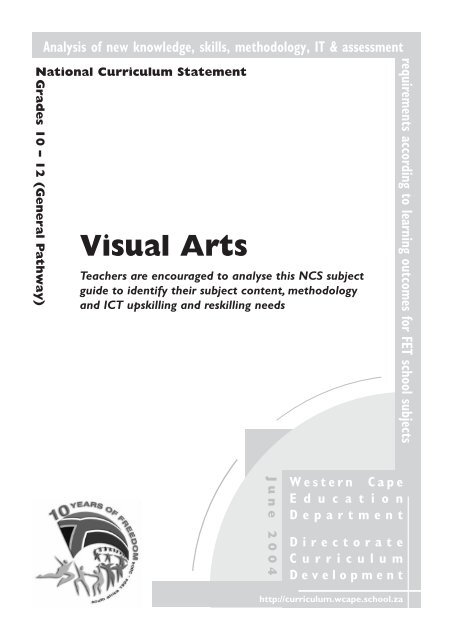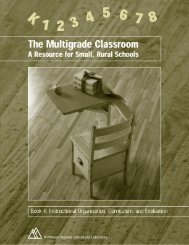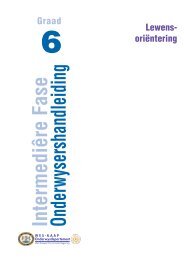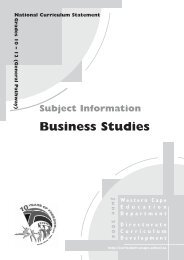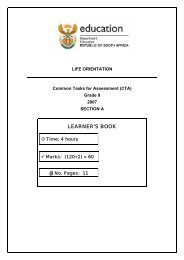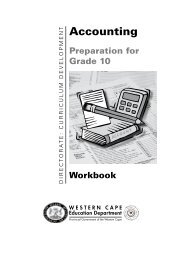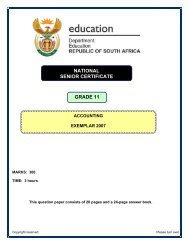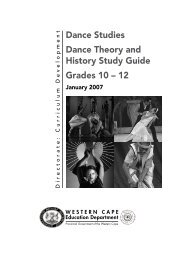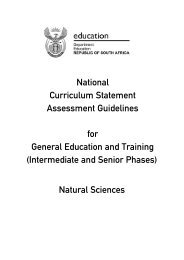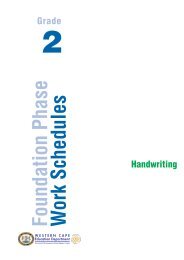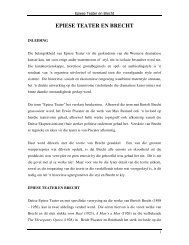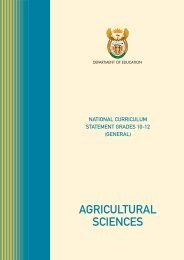eng Visual Arts.pdf - Curriculum Development
eng Visual Arts.pdf - Curriculum Development
eng Visual Arts.pdf - Curriculum Development
- No tags were found...
You also want an ePaper? Increase the reach of your titles
YUMPU automatically turns print PDFs into web optimized ePapers that Google loves.
Analysis of new knowledge, skills, methodology, IT & assessmentNational <strong>Curriculum</strong> StatementGrades 10 – 12 (General Pathway)<strong>Visual</strong> <strong>Arts</strong>Teachers are encouraged to analyse this NCS subjectguide to identify their subject content, methodologyand ICT upskilling and reskilling needsrequirements according to learning outcomes for FET school subjectsJune 2004Western CapeE d u c a t i o nDepartmentDirectorate<strong>Curriculum</strong><strong>Development</strong>http://curriculum.wcape.school.za
FURTHER EDUCATION AND TRAINING BANDVISUAL ARTSArt teachers will find the new FET <strong>Visual</strong> <strong>Arts</strong> curriculum familiar in many respects. For example, teaching, learning and assessment of the practical visual arts disciplineshave traditionally supported outcomes-based methods. Since 1996, the Senior Certificate examinations in History of Art have enabled teachers to approach content in amore contextual, open-ended and interpretative way. In addition, the optional module on Art in Everyday Life, will be an integral part of the new curriculum. However,there are some new aspects and changes of emphasis such as:• FET content, practice and theory, is organised through four inter-related Learning Outcomes: Conceptualising, Making, Personal <strong>Development</strong>, and <strong>Visual</strong> CultureStudies. These Learning Outcomes are accompanied by Assessment Standards (per Grade),• South African visual arts are located within the broader African context as well as in a global society,• Heritage and culture, and the contribution of indigenous knowledge systems (IKS) to our understanding of the visual arts, past and present, is formally introduced,• An understanding of the relationship between the visual arts and issues of civil society e.g. humans rights, globalisation, social and environmental justice etc. isemphasised,• A comparative approach to content and context will be followed,• The Sourcebook: a collection of work gathered by the learner which records the “ journey” undertaken during practical work, research, design theory and history,business context, experimentation and exploration of concepts and ideas. It feeds into every aspect of the learner’s work and is viewed as a developmental recordof the learner’s progress throughout the year. It is presented for assessment at the end of each year, including Grade12.CONTENT KNOWLEDGE SKILLS, PROCESSES,METHODOLOGYLO 1ConceptualisingThe learner is able to explore,develop and realise creative ideasin response to both externally setand self generated projects,drawing on own experience andown knowledge of visual culture inthe past and presentLO 2MakingThe learner is able to explore andmanipulate materials, techniques,processes and technologies in themaking of imaginative andinnovative objects of personalexpressionTeaching, Learning and Assessment willbe informed by the National <strong>Curriculum</strong>Statement and Outcomes Based Educationprinciples and practice.Content in <strong>Visual</strong> <strong>Arts</strong> should assistlearners to progress towards theachievement of the Learning Outcomes.Content must serve the LearningOutcomes and not be an end in itself.Contexts will enable the content to beembedded in situations that are meaningfulto learners and support the teaching of andlearning in <strong>Visual</strong> <strong>Arts</strong>.Teachers should be aware of and makeuse of local contexts. In contexts where thelearner focuses on creative expression, theoutcomes usually reflect the personalexperience of the learner and may evokedifferent responses in the viewers.*ICT POSSIBILITIESBy the time learners leave school at theend of Grade 12. They should becomputer literate, at least at a basiclevel. They should be able to:• Do word processing• Do spread sheets• Access the internet and findinformation on the world wide web• Use emailIn terms of the information that learnersdownload from the web, it is importantthat they are able to:• distinguish between relevant andirrelevant information• understand that they cannot usedownloaded information as is andthat they avoid plagiarism• Where available and appropriate,both teachers and learners shouldhave access to scanners and beable to design power pointpresentationsASSESSMENTAPPROACHESOutcome-based assessment criteria are used for assessingall learner achievement in FET <strong>Visual</strong> <strong>Arts</strong>The Assessment Standards of the four Learning Outcomesare the basic tools for planning and assessmentThe skills and processes that inform methodology areembedded in them. TheAssessment Standards explain what learners need to do todemonstrate achievement of the outcome/sThe criteria derived from the Assessment Standards need tosuit the individual task. Additional criteria not specificallylinked to the assessment standards can also be developedwhen assessing a taskTasks need to be designed to enable learners todemonstrate their achievement/s.Evidence needs to be collected from learners thatdemonstrate achievement of the assessment standards*Teachers should understand the purposeof the Sourcebook which will play a majorrole in teaching, learning and assessment1
CONTENT KNOWLEDGE SKILLS, PROCESSES,METHODOLOGYLO 3Personal <strong>Development</strong>The learner is able to manageeffectively own working process andown personal and professionaldevelopment within the visual artsfieldContent and context, when aligned to theattainment of the Assessment Standards,provide a framework for the developmentof Learning Programmes.- The LOs are interrelated and shouldnot be seen in isolation.- Practical work in LOs 1-3 should beenriched by LO 4 <strong>Visual</strong> CultureStudies (see below) and vice versa.* LO 4<strong>Visual</strong> Culture StudiesThe learner is able to demonstrateknowledge, skills, attitudes andvalues acquired through the study ofthe diverse roles and functions ofthe visual arts in contemporary lifeand in different times and cultures*NB• Some content from Report 550remains although it will becondensed or moved to anothergrade;• Some content will be replaced• Content selection anddevelopment will take placeconsultation with HEI Fine <strong>Arts</strong>faculties and other stakeholdersThe greatest need and chall<strong>eng</strong>e will be forteachers to understand what the term<strong>Visual</strong> Culture Studies encompasses andwhere content and approach to teachingand learning differs from the 550 InterimCore syllabus for History of Art.While aspects of the 550 Interim Coresyllabus (History of Art) provide relevantcontent and contextual knowledge that canbe transferred to <strong>Visual</strong> Culture studies,there will be a greater emphasis on:- Local, national, Southern African andPan African <strong>Visual</strong> <strong>Arts</strong>- Comparative studies- Human rights, Inclusivity, HIV andAids, Environmental and Social justice;- Heritage, Culture and indigenousknowledge systems (IKS)- <strong>Visual</strong> Literacy and <strong>Visual</strong> Culture"The term “<strong>Visual</strong> Culture” encompassesa wide range of forms ranging from fine artto popular film and television to advertisingto visual data in fields that we tend not tothink about in terms of the cultural – thesciences, law and medicine for example…”Sturken and Cartwright(2001), Practices of Looking. p279)• ICT POSSIBILITIES*Information CommunicationTechnologyNB• Popular visual culture and manycontemporary arts practitionersmake use of multimedia andcomputer-generated images,however, all learners must be ableto demonstrate their ability to usebasic practical visual arts skills• Learners should be taught to useand manipulate ICT software in acritical, creative and reflectivemanner which emphasisesinnovation (rather than unthinkingand mechanistic reproduction)• GIS (Geographical InformationSystems) could be used to enrichunderstanding of the ways in whichvisual culture is influenced bygeographical and historicalsituations and conditions which arepertinent and relevant but notusually associated with the study ofvisual artsASSESSMENTAPPROACHESAssessment Standards also show progression of skills,knowledge and values over Grades 10-12 in depth andbreadthThe assessment standards will be used as a basis forreporting and recordingTeachers should understand the principles of progression inFET <strong>Visual</strong> <strong>Arts</strong> and the purpose of different OB assessmentapproaches Teachers must be able to:• develop and use a variety of appropriate <strong>Visual</strong> <strong>Arts</strong>practical and theory tasks for different assessmentpurposes• develop appropriate Continuous Assessment (CASS)tasks for prescribed items including mid year (grade)examinations in <strong>Visual</strong> <strong>Arts</strong> practice and theory thatcomply with Outcomes Based assessment andprovincial, national and Umalusi requirements• develop appropriate end of year (phase) externalexaminations in <strong>Visual</strong> <strong>Arts</strong> practice and theory thatcomply with Outcomes Based assessment andprovincial, national and Umalusi requirements2


